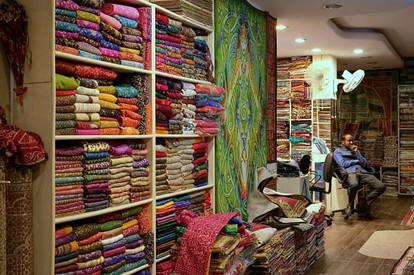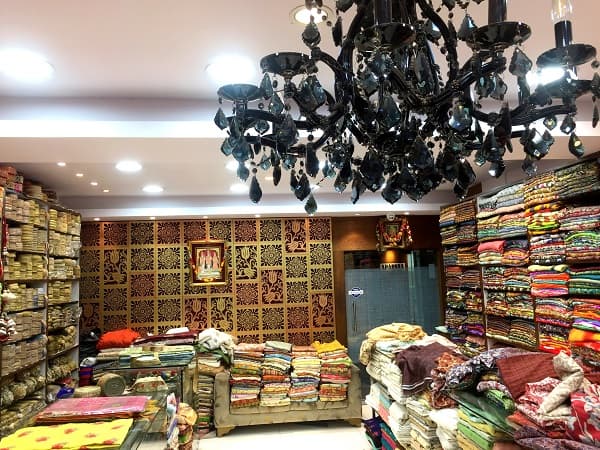Buying Fabrics in India
- Sew, Jahit
- Mar 20, 2019
- 4 min read
Updated: Jan 16, 2024
What fabrics to buy in Jaipur, Agra, Varanasi and Kolkata, how to find the shops, and what to expect from the locals.

Early March, my husband and I had the pleasure of visiting one of the textile capitals of the world - India! I was especially excited because India is the second largest textile exporter in the world, second only to China. And this was very obvious. A walk down any bustling street in any city would verify that statistics.
Our first stop in India was Jaipur, the capital city of the Rajasthan state, also known as the Pink City. Then, we traveled to Agra city for the customary Taj Mahal visit (breathtaking!). From there, we took a train to the spiritual capital of India that is Varanasi, and from there, another train to our last stop, Kolkata.

Not only were textile shops abundant, so were the availability of skillful tailoring services - from those pedaling away old machines on sidewalks to those working behind larger shop names.
Jaipur
Tuk-tuk drivers in tourist locations in India are infamous for unsolicited detours to souvenir shops. Fortunately for me, this was exactly what I wanted.
Our tuk-tuk driver Sumer brought us to a textile shop in Jaipur called Ethnic Textile, where we bought a table runner and I had an outerwear made out of this beautiful cotton satin with a bit of shiny details that I loved so much, but was not confident enough to sew.

I can't say their goods are reasonably priced, because to be honest, some were not. You just need to go with an open mind and don't feel that you must buy anything they show you. Actually, they were quite gracious. There wasn't any hard-selling.
There was another textile shop we found by ourselves while walking around the city near tourist attractions. We did not buy anything there but I can't say I was not tempted. The price was very cheap (a large table cloth for just 500 Indian Rupees, pre-negotiation) but I suspect the quality was not that good.
We also bought these wooden printing blocks that, as it turned out, were only found in Jaipur (at least among the four cities we visited). In fact, Jaipur is famous for block prints.

Varanasi
Varanasi is historically and presently famous for producing fine silk. In the olden days, artisans wove silks solely for the royal families, never for commoners, and much of those artistry obviously still flow in the veins of today's people of Varanasi. While the world has delved into mass production, we were awed to find artisans still weaving silk by hand, using primitive tools and equipment that, in many parts of the world, belonged only in museums.
Textile is a big part of the everyday life in Varanasi, and everywhere we went, it seemed the people interacted with textile almost exactly the same way they did hundreds of years ago, from washing by the Ganges River to ironing with charcoal iron.
Almost like a Standard Operating Procedure, our tour guide Rohit offered to bring us to a textile shop that sold all kinds of fabric but specialised in what Varanasi is famous for - silk. We were happy to oblige but I was a little disappointed, as the shop sold more ready-made items than raw fabrics, such as shawls, scarves, bedsheets, cushion covers and table cloths. Although, they were very beautiful and their workmanship was exquisite. Here, I got myself a silk cashmere shawl and a pure silk scarf, all for 5000 Indian Rupees.
Kolkata
There were no Sumer or Rohit to bring us around Kolkata and recommend us textile shops. So I had to DIY. I researched for a textile shop that is worth an intentional taxi ride to visit. There were more than a few to choose from, and I chose Aparnaa Fabrics at Loudon Street.
I knew exactly what I wanted - the fabric that I can comfortably and confidently sew - cotton. It turned out they had a whole floor for it, and I was whisked to heaven on their old-fashioned elevator (the kind that had steel collapsible doors).

It was a very therapeutic moment for both the husband and I, to see so many beautiful fabrics that we don't usually find in Malaysia. With the price cheap at as low as 200 Indian Rupees per meter (and having many unused Rupees notes on our second last day in India), the only thing limiting us was our luggage space.
Alas, here's our humble stash of chosen fabrics:

Of course, they had fabrics other than cotton. Here is their silk and accessories section:
Conclusion
Shopping in India in general was very pleasant. While it was apparent that there is real want by the merchants for me to buy from them, I did not experience any hard-selling.
I find the people of India very accommodating by nature, and I especially appreciated this when shopping for fabrics because they did not seem to mind at all when I really took my time choosing, feeling the fabrics with my hands, unraveling bolts of fabrics, and snapped so many photographs too. They would really go out of their ways to remove goods from packaging and unfolding stacks of fabrics for me, but they were very gracious even when I ended up not buying anything.
Incredible India, indeed!










































































































































































